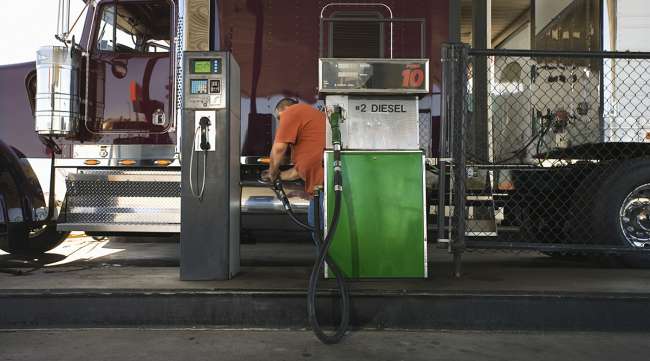Senior Reporter
Diesel Gives Back Increase, Falls 0.4¢ to $2.386

[Stay on top of transportation news: Get TTNews in your inbox.]
The nationwide average price of a gallon of diesel fell 0.4 cents to $2.386, erasing the same increase from a week earlier, according to the Energy Information Administration.
That increase has been the only week-over-week gain of the year. This week's decline left diesel 75 cents per gallon cheaper than the same week last year.
Additionally, the average price of a gallon of gasoline continued to increase, climbing 1.4 cents to $1.974 a gallon. It remains 83.3 cents per gallon cheaper than a year ago.
Diesel, trucking’s primary fuel, declined in nine of the nation’s 10 regions surveyed by EIA — remaining flat in one, the Central Atlantic region where the price of diesel was $2.666 a gallon, 67.8 cents a gallon less than a year ago.
The least expensive diesel is in the Gulf Coast region, where prices fell four-tenths of a cent to $2.171 a gallon, putting it 70.4 cents a gallon less than in 2019.
The most significant drop was in the lower Atlantic region, where the price of diesel dropped 1 cent to $2.349 a gallon, putting the price 66.2 cents less than a year ago.
Average prices fell nine-tenths of a cent in New England to $2.615, 60.4 cents a gallon less than in 2019.
California has the most expensive diesel in the nation, sitting only slightly lower than a week ago, as it dropped one-tenth of a cent to $3.181 a gallon. Even at that price, California has seen the most significant year-over-year decrease in diesel, as a gallon now costs 92.8 cents less than it did in 2019.
In recent weeks the price of oil has stabilized on world markets because of a combination of reasons, including demand starting to creep back up after significantly falling during the coronavirus pandemic.
According to Tom Kloza, founder of the Oil Price Information Service, during March and April world oil demand fell because of COVID-19 to 70% of its usual daily amount of 100 million barrels per day. According to EIA, world oil demand is not expected to return to pre-pandemic levels until sometime in the fourth quarter.

How can trucking companies adjust to ensure that essential freight keeps moving while protecting their workers from coronavirus? Host Seth Clevenger speaks with Lilli Chiu of Hub International and Dave Cox of Polaris Transportation. Hear a snippet, above, and get the full program by going to RoadSigns.TTNews.com.
“We’re still dragging on gasoline demand, and we’re still dragging on diesel demand,” said Kloza. “I think the Saudis and their allies realize that demand is not coming back to pre-COVID rates in the foreseeable future. We’re not looking at some rocket rally.”
Kloza said he anticipates a gradual recovery in the use of gasoline and diesel, with prices remaining in the range they’re in for several more months.
“Refined product prices are really struggling. Demand is probably down about 25% for gas and 20% for diesel,” he said.
One of the reasons why diesel demand remains low, Kloza said, was because of the parking of nearly 500,000 school buses as most school districts across the country were closed and students sent home because of the pandemic.

Kloza
As a result of the pandemic and subsequent recession, the EIA is now projecting domestic U.S. oil production, which had averaged 12.2 million barrels per day in 2019, will drop throughout the remainder of 2020 and into 2021.
In its latest forecast, the energy agency said U.S. crude production will average 11.7 million barrels per day in 2020 and 10.9 million barrels per day in 2021. These levels would be 500,000 barrels per day in 2020 and 1.3 million barrels per day in 2021 less than what the U.S. was producing pre-pandemic in 2019 and early 2020.
Meanwhile, the oil field services company Baker Hughes, which tracks the number of oil rigs in the U.S. daily, reported on May 29 rigs operating in-country fell by 17 in one week to 301. Still, when compared with the same week a year ago, the drop was 683, when nearly 1,000 rigs were in operation.
“Demand is still depressed,” Kloza said. “If prices advance, it’s going to advance mostly on supply constraints, as opposed to a return to normalcy in demand. I’m just not seeing it. There’s not a feel-good sense of spending money and taking trips in the country right now.”
Want more news? Listen to today's daily briefing:
Subscribe: Apple Podcasts | Spotify | Amazon Alexa | Google Assistant | More




